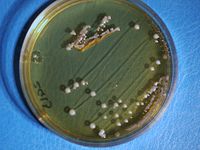
Photo from wikipedia
Recent research demonstrated that some Listeria monocytogenes plasmids contribute to stress survival. However, only a few studies have analyzed gene expression patterns of L. monocytogenes plasmids. In this study, we… Click to show full abstract
Recent research demonstrated that some Listeria monocytogenes plasmids contribute to stress survival. However, only a few studies have analyzed gene expression patterns of L. monocytogenes plasmids. In this study, we identified four previously published stress‐response‐associated transcriptomic data sets which studied plasmid‐harboring L. monocytogenes strains but did not include an analysis of the plasmid transcriptomes. The four transcriptome data sets encompass three distinct plasmids from three different L. monocytogenes strains. Differential gene expression analysis of these plasmids revealed that the number of differentially expressed (DE) L. monocytogenes plasmid genes ranged from 30 to 45 with log2 fold changes of −2.2 to 6.8, depending on the plasmid. Genes often found to be DE included the cadmium resistance genes cadA and cadC, a gene encoding a putative NADH peroxidase, the putative ultraviolet resistance gene uvrX, and several uncharacterized noncoding RNAs (ncRNAs). Plasmid‐encoded ncRNAs were consistently among the highest expressed genes. In addition, one of the data sets utilized the same experimental conditions for two different strains harboring distinct plasmids. We found that the gene expression patterns of these two L. monocytogenes plasmids were highly divergent despite the identical treatments. These data suggest plasmid‐specific gene expression responses to environmental stimuli and differential plasmid regulation mechanisms between L. monocytogenes strains. Our findings further our understanding of the dynamic expression of L. monocytogenes plasmid‐encoded genes in diverse environmental conditions and highlight the need to expand the study of L. monocytogenes plasmid genes' functions.
Journal Title: MicrobiologyOpen
Year Published: 2022
Link to full text (if available)
Share on Social Media: Sign Up to like & get
recommendations!